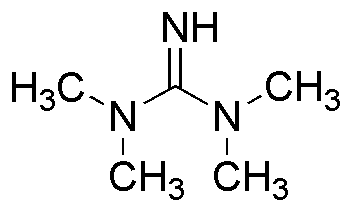1,1,3,3-Tetramethylguanidine is widely utilized in research focused on
- Organic Synthesis: This compound serves as a strong base in various organic reactions, facilitating the synthesis of complex molecules in pharmaceuticals and agrochemicals.
- Catalysis: It acts as an effective catalyst in reactions such as the synthesis of amines, enhancing reaction rates and yields compared to traditional catalysts.
- Polymer Chemistry: Used in the production of polymers, it helps in the development of high-performance materials with improved thermal and mechanical properties.
- Analytical Chemistry: This chemical is employed in analytical methods to improve the sensitivity and selectivity of detection techniques, aiding in the analysis of various substances.
- Biochemistry: It plays a role in biochemical research, particularly in studying enzyme mechanisms and interactions, providing insights into biological processes.
General Information
Properties
Safety and Regulations
Applications
1,1,3,3-Tetramethylguanidine is widely utilized in research focused on
- Organic Synthesis: This compound serves as a strong base in various organic reactions, facilitating the synthesis of complex molecules in pharmaceuticals and agrochemicals.
- Catalysis: It acts as an effective catalyst in reactions such as the synthesis of amines, enhancing reaction rates and yields compared to traditional catalysts.
- Polymer Chemistry: Used in the production of polymers, it helps in the development of high-performance materials with improved thermal and mechanical properties.
- Analytical Chemistry: This chemical is employed in analytical methods to improve the sensitivity and selectivity of detection techniques, aiding in the analysis of various substances.
- Biochemistry: It plays a role in biochemical research, particularly in studying enzyme mechanisms and interactions, providing insights into biological processes.
Documents
Safety Data Sheets (SDS)
The SDS provides comprehensive safety information on handling, storage, and disposal of the product.
Product Specification (PS)
The PS provides a comprehensive breakdown of the product’s properties, including chemical composition, physical state, purity, and storage requirements. It also details acceptable quality ranges and the product's intended applications.
Certificates of Analysis (COA)
Search for Certificates of Analysis (COA) by entering the products Lot Number. Lot and Batch Numbers can be found on a product’s label following the words ‘Lot’ or ‘Batch’.
*Catalog Number
*Lot Number
Certificates Of Origin (COO)
This COO confirms the country where the product was manufactured, and also details the materials and components used in it and whether it is derived from natural, synthetic, or other specific sources. This certificate may be required for customs, trade, and regulatory compliance.
*Catalog Number
*Lot Number
Safety Data Sheets (SDS)
The SDS provides comprehensive safety information on handling, storage, and disposal of the product.
DownloadProduct Specification (PS)
The PS provides a comprehensive breakdown of the product’s properties, including chemical composition, physical state, purity, and storage requirements. It also details acceptable quality ranges and the product's intended applications.
DownloadCertificates of Analysis (COA)
Search for Certificates of Analysis (COA) by entering the products Lot Number. Lot and Batch Numbers can be found on a product’s label following the words ‘Lot’ or ‘Batch’.
*Catalog Number
*Lot Number
Certificates Of Origin (COO)
This COO confirms the country where the product was manufactured, and also details the materials and components used in it and whether it is derived from natural, synthetic, or other specific sources. This certificate may be required for customs, trade, and regulatory compliance.


